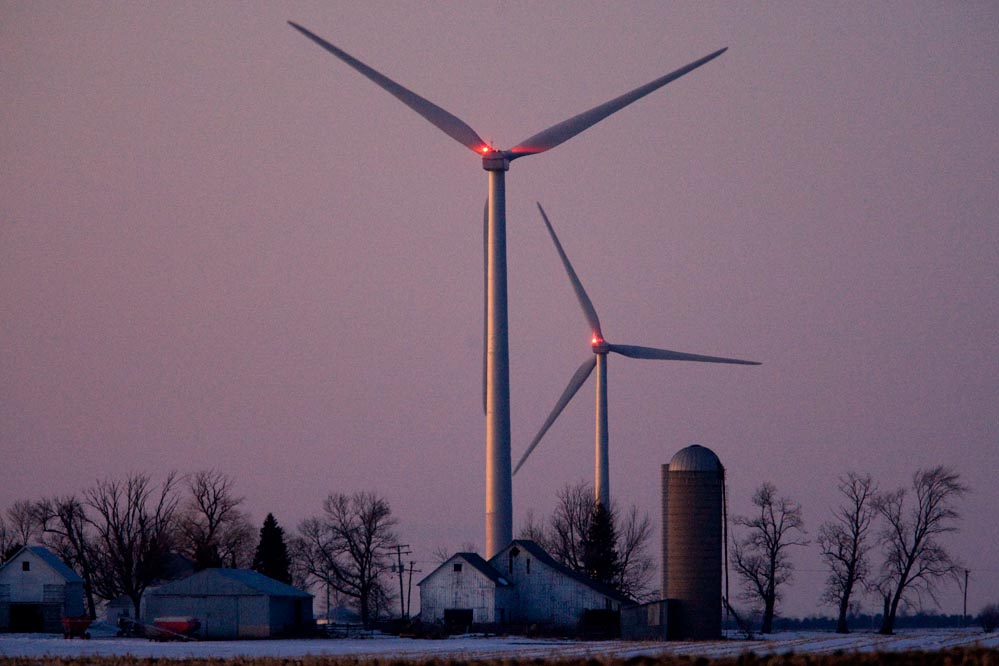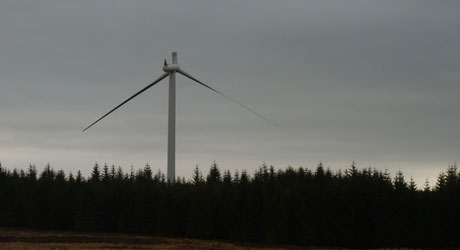3/23/10 TRIPLE FEATURE: What made the 150 blade snap off the turbine? AND What they are saying in DeKalb County, IL AND On the subject of Wind Turbine Syndrome, the doctor is IN
Wind farm shut down over safety fears after 150 ft turbine blade falls off
SOURCE: The Daily Record, www.dailyrecord.co.uk
March 23, 2010
Exclusive by Ben Spencer
Europe’s largest wind farm ground to a halt after a 150ft blade snapped off one of the turbines.
All 140 of the giant machines were immediately shut down at the £300million development near Glasgow until they could be inspected.
Engineers at Whitelee wind farm, which is run by ScottishPower Renewables, were trying to work out why the blade came crashing down.
They are looking into whether lightning could have struck the turbine or if it was caused by a mechanical problem.
It sheared off and hit the ground in the early hours of Friday morning in blustery conditions.
Automatic systems alerted operators in the control room to the damage and they immediately closed down the unit.
All 420 blades in the wind farm were being examined following the accident.
Last night, more than 50 turbines were expected to have been inspected and safely returned to operation.
The process is expected to be completed by Friday.
Whitelee wind farm’s visitor centre, which is managed by Glasgow Science Centre and had been due to reopen after the winter break yesterday, stayed shut.
German company Siemens, who supplied the turbines, are also understood to be investigating.
The 360ft turbines are so massive that engineers have been able to climb inside them to try to detect the problem.
Over the weekend, the site at Eaglesham Moor, 13 miles from Glasgow city centre, was cordoned off to keep visitors away. Raymond Toms, 45, a teacher from East Kilbride, spotted the broken turbine as he cycled past on Sunday.
He said: “I was out for a bike ride and I saw one of the massive blades had broken clean off. It was quite unnerving really.
“You can walk right up to these things normally and touch them.
“The public have access to the network of pathways nearby.
“I have grave concerns over the safety of the public, who can walk right up to the turbines.
“It’s worrying that if one of these could fall off then perhaps another one could.
“It’s made me think about going too close, that’s for sure. It’s just lucky this took place at night, when nobody was around.”
Keith Anderson, managing director of ScottishPower Renewables, said: “This type of incident is exceptionally rare and highly unusual.
“However, the safety of our people and the public is our first priority.
“While the investigation into the cause of the incident is ongoing, our engineers continue to conduct an internal and external examination of all turbine blades at the wind farm”.
A spokesman for the firm added: “Investigations are ongoing, and a number of possibilities including mechanical failure and lightning strike are being considered.
“Operators in the 24-hour control room immediately closed the turbine down.
“This is a highly unusual situation. I’ve not heard of this kind of incident happening in 30 years.”
GREEN ENERGY BLUEPRINT
Whitelee was officially switched on in May 2009 by First Minister Alex Salmond.
Each turbine at Whitelee, which started producing electricity in January 2008, stands 360ft high.
The wind farm has 140 turbines that can generate 322 megawatts of electricity, enough to power 180,000 homes.
ScottishPower Renewables have been given permission to add 36 turbines to the site, allowing the wind farm to power 250,000 homes and create up to 300 jobs.
Last week, it was revealed that community groups in East Renfrewshire are to benefit from a fund set up from the development of Whitelee.
The fund will deliver about £140,000 a year for the next 25 years to the area’s council for local groups.

SOURCE: A Photo Blog :: Chicago Photojournalist Alex Garcia
Most people when asked are in favor of wind energy. Green. No foreign oil. No spent fuel rods. Cool-looking turbines.
But when a reporter and I went out to DeKalb County to talk to residents embroiled in a lawsuit surrounding a wind farm installed in an otherwise tranquil setting, we heard quite an earful.
Residents pitted against each other, noise, shadow flicker, lost sleep, stress, dead animals, lower real estate values, lost sightlines. It was a long list of complaints.
Although many people wrote off their grievances as little more than NIMBY, you do have to wonder whether 1400 feet is the sufficient amount of distance that a turbine should be from the foundation of a home.
Landowners who allowed the wind turbines on their properties are to be paid $9000 a year, per turbine, for the privilege. Some had a few. In this economy, I can see it from their perspective too. In this case, however you look at it, the wind blew up a storm.
SECOND FEATURE:
Letter from Dr. Nina Pierpont against siting wind turbines near home
SOURCE: Wind Concerns, Ontario
I am told that wind developers are proposing to build industrial-scale wind turbines as close as 270 meters [less than 900 feet] from people’s homes.
This is a reckless and violent act. The evidence for turbines producing substantial low frequency noise and, worse, infrasound, is no longer in dispute.
The clinical evidence is unambiguous that low frequency noise and infrasound profoundly disturb the body’s organs of balance, motion, and position sense.
The case studies performed by me and other medical doctors have demonstrated unequivocally that people living within 2 km of turbines are made seriously ill, often to the point of abandoning their homes.
There is no doubt among otolaryngologists and neuro-otologists who have studied the evidence that wind turbine low frequency noise and infrasound are seriously disrupting the body’s vestibular organs, resulting in the constellation of illness I have called Wind Turbine Syndrome.
The cure for Wind Turbine Syndrome is simple: Move away from the turbines or shut off the turbines.
The prevention of Wind Turbine Syndrome is even simpler: Don’t build these low frequency/infrasound-generating machines within 2 km of people’s homes.
Governments and corporations who violate this principle are guilty of gross clinical harm. Such governments and corporations should be taken before whatever level of court is necessary to stop this outrage.
I realize these are strong words. They are carefully chosen. They are strong because governments and the wind industry stubbornly—I would add, criminally—refuse to acknowledge that they are deliberately and aggressively harming people. This must stop. The evidence is overwhelming. I repeat, this must stop.
Nina Pierpont, MD, PhD
Fellow of the American Academy of Pediatrics
Former Clinical Assistant Professor of Pediatrics, College of Physicians & Surgeons, Columbia University, New York

